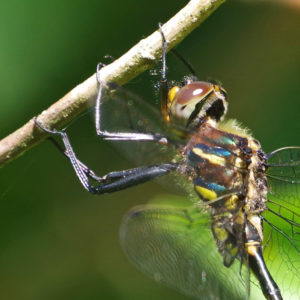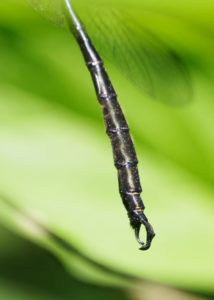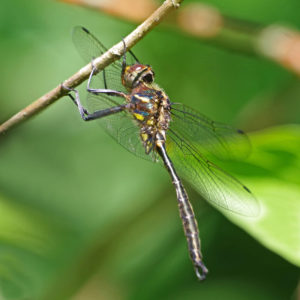Greetings, BugFans,
One of the dragonflies that the BugLady encountered this summer was a Federally Endangered Hine’s Emerald. Unlike her usual subjects, there are lots of internet hits about the dragonfly, and many are state and federal informational and management bulletins.
Emeralds are in the dragonfly family Corduliidae, the so-called “Green-eyed Skimmers” (though “Skimmers” commonly refers to a different dragonfly family). There are smaller species in the family, like baskettails, the very rare Boghaunters, and the very common Racket-tailed Emerald . And then there are the two dozen North American members of the genus Somatochlora (the Striped Emeralds), a group of large dragonflies, many of which have ranges well into Canada. The BugLady included Hine’s Emeralds in an overview of the emeralds that she wrote in 2009, after she found a road-killed Hine’s Emerald near the UWM Field Station.
The story is legend. It was the final sweep of a two-day dragonfly workshop at the Field Station in 1999—early afternoon on a hot day—when someone netted a Hine’s Emerald (Somatochlora hineana). At that time, there were known populations of Hine’s Emeralds in northern Michigan, northern Illinois, and in Door County, Wisconsin.
 The species was described in 1931, which seems pretty late in the game for a large dragonfly (2 ½” long with a 3 ½” wingspan) to go unnoticed, but it was hiding in plain sight. It’s closely related to the very-similar Clamp-tipped Emerald (Somatochlora tenebrosa). (Tenebrosa means “dark” or “gloomy.”) The two species seek similar habitats, and the Hine’s Emerald shares a small bit of tenebrosa’s range. The Hines is separated from the rest of the green-eyed , green-bodied Somatochlora emeralds by the shape of the two yellow stripes on a green thorax and by the shape of the male’s claspers.
The species was described in 1931, which seems pretty late in the game for a large dragonfly (2 ½” long with a 3 ½” wingspan) to go unnoticed, but it was hiding in plain sight. It’s closely related to the very-similar Clamp-tipped Emerald (Somatochlora tenebrosa). (Tenebrosa means “dark” or “gloomy.”) The two species seek similar habitats, and the Hine’s Emerald shares a small bit of tenebrosa’s range. The Hines is separated from the rest of the green-eyed , green-bodied Somatochlora emeralds by the shape of the two yellow stripes on a green thorax and by the shape of the male’s claspers.
 A paper written by E. B. Williamson describing and naming the new species was published in the Occasional Papers of the Museum of Zoology, University of Michigan, Ann Arbor, June 3, 1931. Williamson wrote: “Early in June, 1929, Professor Kennedy [both Williamson and Kennedy eventually had emeralds named after them] wrote me that Professor Hine had just come in from a collecting trip with an undescribed Somatochlora male. This was the male taken June 7 by Professor Hine, who later showed me the place where it was captured.”
A paper written by E. B. Williamson describing and naming the new species was published in the Occasional Papers of the Museum of Zoology, University of Michigan, Ann Arbor, June 3, 1931. Williamson wrote: “Early in June, 1929, Professor Kennedy [both Williamson and Kennedy eventually had emeralds named after them] wrote me that Professor Hine had just come in from a collecting trip with an undescribed Somatochlora male. This was the male taken June 7 by Professor Hine, who later showed me the place where it was captured.”
He continued: “In this woods is a heronry which Professor Hine visited on June 7, 1929. Leaving the woods along its northern side where it adjoins a golf course, he saw a dragonfly hovering two or three feet above the ground in an open spot under a bush. This was captured, and was later referred to Professor Kennedy who recognized it as an undescribed species. He and Professor Hine returned to the site on June 14. The day was rainy and apparently unfavorable. They failed to find any Somatochloras in the woods, but on visiting the dredged channel they were able to take five specimens resting on low bushes on the wood’s side of the high bank of earth thrown up by the dredge when the channel was dug…..
In 1930 no Somatochloras were certainly seen by any of us, except the single female taken by Eli Captain. This was first seen soaring at almost tree top height, from which it descended to alight about ten feet high in a small ash tree on the bank of the dredged channel. In 1930 our party divided at each visit and we searched carefully the full length of the creek, including both banks of the dredged channel, the adjacent forest and pools, and the edges of the forest along the golf course, thickets, old meadows, and grain fields. Until we discover where females oviposit, the search for this species promises but little results.”
Experts guess that the original range of the Hine’s Emerald included Alabama, Indiana, and Ohio, but it is not found in any of those states anymore. Today, it occurs in Ontario, Wisconsin, Michigan, Illinois, and Missouri .Kurt Mead, in Dragonflies of the North Woods, speculates that “Hines may have been relatively widespread in the Great Lakes region before many of the wetlands were drained.” The Wisconsin Odonata Survey website reports sightings from Columbia, Ozaukee, Iowa, and Door counties, with Door containing the largest breeding population anywhere, estimated at 20,000. It has been suggested that with laboratory rearing, the range of Hine’s Emeralds might be expanded to suitable habitat from Minnesota and Maine on the north, to Texas and Georgia on the south.
But, they’re pretty picky about habitat, preferring dry fens and sedge meadows with cool, slow-moving, calcareous, spring-fed seepages for their offspring, and open woodland nearby for the adults. The wetlands must contain crayfish burrows. .
Crayfish burrows? Most dragonflies go from egg through adult in the course of a calendar year. Depending on water temperatures and food, Hine’s Emeralds spend up to five years as hairy naiads in those calcareous fens (click on the “Hine’s Emerald Nymph” ), and during that time, they shelter in crayfish burrows. As conditions in their shallow wetlands get drier in late summer, the water in the burrow is welcome, and their hairs discourage evaporation of moisture from their body. See the diagram . Hunkering down in crayfish burrows has two down-sides; one for the naiads—crayfish do eat them—and one for the researchers—it’s hard to count critters that are hiding in crayfish burrows. They must pump the burrows to see what’s there. See the videos below.
When they became the first (and, so far, the only) dragonfly placed on the Federal Endangered Species list in 1995, not much was known about their natural history. Since then, researchers at a variety of state and federal agencies in Illinois and Wisconsin have filled in a lot of the gaps.
Threats to the Hine’s Emerald include the usual suspects – extreme habitat specialization, habitat loss/degradation, pollution and pesticides that affect both its prey and its naiads, competition for water that affects the water table, and collisions with cars. These are being countered by research, habitat protection (initially, the dragonfly was protected but not its habitat), a recovery plan, education, and, yes, lowered speed limits in some sensitive areas.
Interesting Hine’s Emerald fact: in many studies, although there are roughly the same numbers of emerging males and females in an area, flying males greatly outnumber females a short time later. One hypothesis is that the activities around reproduction are more costly for females. Fewer females results in less diversity in the gene pool.
Here are two videos – one long , and one short .
Finally, Hine’s Emeralds were named by E. B. Williamson, an Indiana banker whose heart belonged to dragonflies and who was well-respected by scientists in the field. He identified a number of new dragonfly species (and he also bred award-winning irises). His observations of Spatterdock Darners appeared in a recent BOTW. Who was Hine?
James S. Hine (1866 – 1930) was an Ohio zoologist who published on robber flies, horse flies, and planthoppers, among other groups. Because of his exhaustive field work, he knew intimately the nooks and crannies of Ohio. Williamson’s paper describing the emerald and naming it for Hine, was published after Hine’s death, and it included a brief obituary. After citing his friend’s professional accomplishments, Williamson wrote “He will be remembered longest for his work on Diptera, especially the Tabanidae. In this group his flair for taxonomy and his unflagging industry for more than a quarter of a century built a temple of Truth for his monument. To that temple I bring this small urn to place in the alcove where rest Rhodopygia hinei Calvert [a Costa Rican dragonfly] and Argia hinei Kennedy [a southwestern damselfly], witnesses of his love of dragonflies and of the affection and appreciation of his colleagues.”
Thanks to BugFan Bill, who knows the secret handshake and unearthed a journal article for the BugLady.
The BugLady
